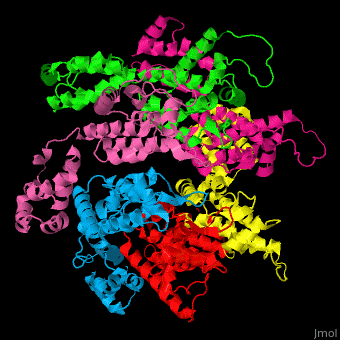Virus coat protein
From Proteopedia
Virus coat proteins (VCP) or capsid proteins coat the virus[1]. The various VCPs are designated as Vp1, Vp2, etc. The VCP P domain (protruding domain) in noroviruses binds histo blood group antigen receptors. The outer capsid protein VP4 is a virus spike-forming protein which mediates the virial attachment to the host epithelial cell receptors. The distal portion of Vp4 - Vp8* - is implicated in binding the cellular receptor[2]. VP4 is an outer capsid protein of non-enveloped viruses. VP4 attaches to sialic acid or to integrin heterodimers[3]. VP4 domains include: VP5* which forms the foot of the spike and acts in the permeabilization of the cell membrane and VP8* which forms the head of the spike and binds to sialic acid. The biological assembly of HIV-I coat protein is homohexamer (PDB entry 3gv2).
3D structures of virus coat proteins |
| ||||||||||
References
- ↑ CASPAR DL, KLUG A. Physical principles in the construction of regular viruses. Cold Spring Harb Symp Quant Biol. 1962;27:1-24. doi:, 10.1101/sqb.1962.027.001.005. PMID:14019094 doi:http://dx.doi.org/10.1101/sqb.1962.027.001.005
- ↑ Liu Y, Huang P, Tan M, Liu Y, Biesiada J, Meller J, Castello AA, Jiang B, Jiang X. Rotavirus VP8*: phylogeny, host range, and interaction with histo-blood group antigens. J Virol. 2012 Sep;86(18):9899-910. doi: 10.1128/JVI.00979-12. Epub 2012 Jul 3. PMID:22761376 doi:http://dx.doi.org/10.1128/JVI.00979-12
- ↑ Mackow ER, Barnett JW, Chan H, Greenberg HB. The rhesus rotavirus outer capsid protein VP4 functions as a hemagglutinin and is antigenically conserved when expressed by a baculovirus recombinant. J Virol. 1989 Apr;63(4):1661-8. PMID:2538649

